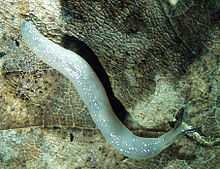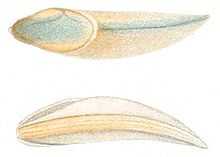Boettgerilla pallens
| Boettgerilla pallens | |
|---|---|
 | |
| Boettgerilla pallens | |
| Scientific classification | |
| Kingdom: | Animalia |
| Phylum: | Mollusca |
| Class: | Gastropoda |
| (unranked): | clade Heterobranchia clade Euthyneura clade Panpulmonata clade Eupulmonata clade Stylommatophora informal group Sigmurethra clade limacoid clade |
| Superfamily: | Limacoidea |
| Family: | Boettgerillidae |
| Genus: | Boettgerilla |
| Species: | B. pallens |
| Binomial name | |
| Boettgerilla pallens Simroth, 1912[1] | |
| Synonyms[2] | |
|
Boettgerilla vermiformis Wiktor, 1959[3] | |
Boettgerilla pallens, common name the worm slug, is a European species of air-breathing land slug, a terrestrial pulmonate gastropod mollusk in the family Boettgerillidae.
Distribution
The type locality of Boettgerilla pallens is Gudauta in Abkhazia.[1][4]
The native distribution of Boettgerilla pallens is believed to be the SW flank of the Caucasus:
Maybe it is also native to the Crimean Mountains and Donetsk Upland in Ukraine[5]
But the species has spread spectacularly over the last half century. Dates of first recorded occurrences in various countries are listed in.[6]
In Europe, Boettgerilla pallens was first found in 1949 (in Germany).[7] It has now been become naturalized widely in Central Europe, Northern Europe and Western Europe and Eastern Europe including:
- Ireland - since 1973[8]
- Great Britain - since 1972[8][9]
- France[10]
- Belgium[2][10]
- Netherlands[2]
- Germany[7][11]
- Switzerland.[12]
- Austria[2]
- Czech Republic[13]
- Slovakia[14]
- Poland - since 1956, mainly in the south-western Poland[15]
- Finland[2][16]
- Sweden
- Lithuania[17]
- Moscow, St. Petersburg and other cities in Russia[4]
- Romania[2]
- Ukraine - Kyiv, Lviv, Ivano-Frankivsk, Vinnytsia, some cities of Crimea and others[5]
- several more countries, but conspicuously not from southern European ones.[6]
Outside Europe it is also known, presumed as an introduction, from:
Description

Boettgerilla pallens is very narrow and slender slug, almost worm-like and sharply keeled.[8] The color is pale greyish or with bluish hue.[8] The head and keel is slightly darker.[8] The mantle is pointed at its posterior end and equipped with fine concentrical grooves.[8] Sole is pale yellow.[8] Mucus is colourless.[8] Juveniles are yellowish to dirty white.[8]
The body length is up to 60 mm.[8] The width is up to 3 mm.[8]
The shell is small, fragile, 1.5-3 x 0.8-1.5 mm, with median nucleus and growth lines, denser in the posterior part, no thin margin, located below the very terminal section of the pointed end of the mantle.[8]
Reproductive system: Penis is elongate and broader than vagina, epiphallus and spermatheca.[8] Epiphallus is swollen and connected to penis laterally near its posterior end, by a long thin duct, which is thinner than vas deferens.[8] Vagina as long as penis and almost as narrow as vas deferens.[8] There are no accessory glands.[8] The spermatheca is elongate and relatively short.[8]
Boettgerilla pallens is much more slender than Milax gagates. The sole is more slender.[8] In Milax gagates the posterior end of the mantle is rounded, its shell is larger and better visible, its colour more yellowish-brownish.[8]

Ecology
Reise et al. (2000)[6] review aspects of the species distribution, mode of range expansion, and other aspects of its ecology.
Boettgerilla pallens inhabits a very wide range of habitats, including gardens, grassland, coniferous and deciduous woodland, and is tolerant of a wide range of soil pH, calcium content and water content.[6][20] It lives at altitudes of up to 1750 m in the Caucasus[2] and in Switzerland at up to 1600 m, but usually below 700 m[12] It can be considered as synanthropic,[2][15] although it is now often found also in undisturbed habitats.[6]
Although it may often been found under logs and stones, it is predominantly subterranean, adapted to moving through earthworm burrows and similar spaces in soil, 2–20 cm (maximum up to 60 cm) below surface.[21] Snails move rapidly away from bright light sources.[21]
Feeding is seldom intensive: slugs usually take a few bites (earthworm faeces, detritus etc., also arionid eggs) and move on.[21][22] It has been considered as a pest in European greenhouses and gardens, because slugs feed on soft plant tissues.[20]
Mating and egg-laying is during late summer and into autumn in Britain (October in Germany).[21] Eggs are laid as several 1-6 egg clutches 9–27 cm deep below the surface.[21] Adults survive egg-laying but die shortly afterwards.[21] Juveniles hatch after 20–22 days at 17 °C (in Germany),[22] between October and December (in Britain).[21] Juveniles turn colour from white to grey in May–June.[21]
References
This article incorporates public domain text from the reference.[8]
- ↑ 1.0 1.1
 (German) Simroth H. (1912). "Neue Beiträge zur Kenntnis der kaukasischen Nacktschneckenfauna". St. Petersburg (Russia), 1-140. 10 Plates. 55-58. Table 3, figure 50, table 8, figure 32.
(German) Simroth H. (1912). "Neue Beiträge zur Kenntnis der kaukasischen Nacktschneckenfauna". St. Petersburg (Russia), 1-140. 10 Plates. 55-58. Table 3, figure 50, table 8, figure 32. - ↑ 2.0 2.1 2.2 2.3 2.4 2.5 2.6 2.7 (Polish) Wiktor A. (1989). Limacoidea et Zonitoidea nuda. Slimaki pomrowioksztaltne (Gastropoda: Stylommatophora). Fauna Poloniae 12, Polska Akademia Nauk, Warszawa, 208 pp., page 137-139.
- ↑ Wiktor A. (1959). "Boettgerilla vermiformis n. sp. (Mollusca, Pulmonata)". Communication of the Poznań Society of Friends of Science, Department of Mathematical and Natural Sciences, 4.
- ↑ 4.0 4.1 4.2 4.3 4.4 Kantor Yu I., Vinarski M. V., Schileyko A. A. & Sysoev A. V.(published online on December 22, 2009). "Catalogue of the continental mollusks of Russia and adjacent territories". Version 2.3.
- ↑ 5.0 5.1 Balashov I.A. & Baidashnikov A.A. 2012.The first findings of a slug Boettgerilla pallens (Stylommatophora, Boettgerillidae) in Crimea Ruthenica. 22(2): 111-114.
- ↑ 6.0 6.1 6.2 6.3 6.4 6.5 Reise, H.; Hutchinson, J.M.C.; Forsyth, R.F.; Forsyth, T. (2000). "The ecology and spread of the terrestrial slug Boettgerilla pallens in Europe with reference to its recent discovery in North America". The Veliger 43: 313–8.
- ↑ 7.0 7.1 Schmid, G. (1966). "Weiter Funde von Boettgerialla vermiformis.". Mitteilungen der Deutschen Malakologischen Gesellschaft 1: 131–136.
- ↑ 8.0 8.1 8.2 8.3 8.4 8.5 8.6 8.7 8.8 8.9 8.10 8.11 8.12 8.13 8.14 8.15 8.16 8.17 8.18 8.19 "Species summary for Boettgerilla pallens". AnimalBase, last modified 28 December 2008, accessed 8 September 2010.
- ↑ Colville, B.; Lloyd-Evans, L.; Norris, A. (1974). "Boettgerilla pallens Simroth, a new British species". Journal of Conchology 28 (4): 203–208.
- ↑ 10.0 10.1 Schmid, G. (1969). "Boettgerilla vermiformis auch in Frankreich und Belgien". Mitteilungen der Deutschen Malakologischen Gesellschaft 2: 20–21.
- ↑ (German) Schmid G. (1962). "Boettgerilla vermiformis Wiktor, 1959, eine neue Nacktschnecke in Deutschland (Gastropoda, Parmacellidae)". Archiv für Molluskenkunde 91: 105-108.
- ↑ 12.0 12.1 Turner, H. et al. (1998). Fauna Helvetica 2: Atlas der Mollusken der Schweiz und Liechtensteins. Terreaux, Neuchatel: Centre suisse de catographie de la faune.
- ↑ (Czech) Hudec V. & Mácha S. (1961). "Pozoruhodný plž z rodu Boettgerilla Simr. na Ostravsku - nový druh pro ČSSR". Přirodovědecký Časopis Slezký 22: 303-310.
- ↑ Lisický M. J. (1991). Mollusca Slovenska. Veda, Bratislava: 1-341.
- ↑ 15.0 15.1 (Polish) Stworzewicz E. (2008-2010). "Boettgerilla pallens Simroth, 1912". Invasive Alien Fauna in Poland. accessed 8 September 2010.
- ↑ Valovirta, I.; Nikkinen, A. (1970). "Boettgerilla vermiformis Wiktor (Gastropoda, Parmacellidae) found in Finland". Annales Zoologici Fennici 7: 188–190.
- ↑ (Lithuanian) Šatkauskienė I. (2001). "Naujos šliužu rušies Lietuvoje - Boettgerilla pallens ir retuju Lietuvos sausumos moliusku rušiu apžvalga" [A REVIEW OF RARE LITHUANIAN TERRESTRIAL MALACOFAUNA SPECIES AND THE BOETTGERILLA PALLENS SPECIES NEW TO LITHUANIA]. Ekologija (Vilnius) 2: 56-60. PDF.
- ↑ Wiktor, A. (1994). "Contribution to the knowledge of the slugs of Turkey (Gastropoda terrestria nuda)". Archiv für Molluskenkunde 123: 1–47.
- ↑ Hausdorf B. (May 2002). "Introduced land snails and slugs in Colombia". Journal of Molluscan Studies 68 (2): 127–131. doi:10.1093/mollus/68.2.127. PMID 12011238.
- ↑ 20.0 20.1 De Wilde, J.J.; Van Goethem, J.L.; Marquet, R. (1983). "Over de verspreiding, de uitbreiding en de oecologie van Boettgerilla pallens Simroth, 1912 in Belgie". Studiedocumenten van het K.B.I.N., Brussel 12: 1–31.
- ↑ 21.0 21.1 21.2 21.3 21.4 21.5 21.6 21.7 Gunn, A. (1992). "The ecology of the introduced slug Boettgerilla pallens (Simroth) in North Wales". Journal of Molluscan Studies 58 (4): 449–453. doi:10.1093/mollus/58.4.449.
- ↑ 22.0 22.1 Daxl, R. (1967). "Ein Beitrag zur Biologie von Boettgerilla vermiformis Wiktor 1959". Zeitschrift für angewandte Zoologie 54: 227–231.
Further reading
- (German) Schmid G. (1963). "Zur Verbreitung und Anatomie der Gattung Boettgerilla". Archiv für Molluskenkunde 92: 215-225.